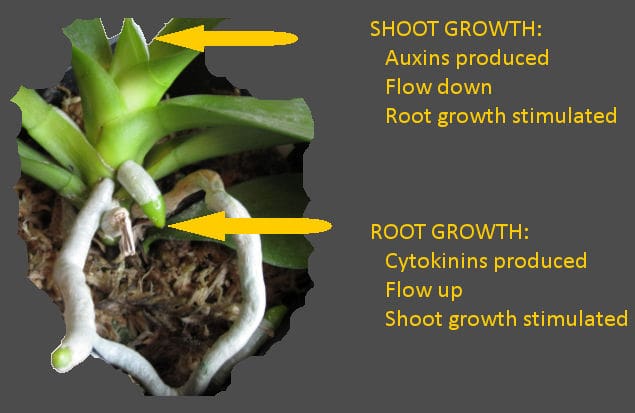Orchid roots are quite sensitive to abuse, so it is perfectly natural that we orchid growers have a lot of interest in root growth stimulants to compensate for our cultural shortcomings. Unfortunately, it is possible to damage your plants if they are not properly used.
The nature of root growth stimulants
Root growth stimulation is based upon auxins, which are hormones produced by the apical growth meristem in shoots. (The “meristem” is a cluster of undifferentiated cells at the plant’s “growth front” that can become stems, leaves, flowers or roots, depending upon how the chemical signals within the plant directs them.) As that plant tissue grows, the auxins travel down the plant and stimulate roots to grow, so there is more of them to take up water and nutrients.

The most common auxin is indole acetic acid (IAA). There are synthetic analogs, naphthalene acetic acid (NAA) and indole butyric acid (IBA) that are well known to stimulate root growth in plants as well, and are used extensively in commercial root growth stimulants. Superthrive contains one of those two, while Dyna-Gro KLN has both.
As the root meristem grows, it releases cytokinins, and other class of hormones, that travel up the vascular structure and stimulate shoot growth, so you end up with a natural, cyclic back-and-forth, steady level of overall growth stimulation. When you manually apply either type of hormone, it kicks the stimulation cycle to a higher level, accelerating growth, then gradually fading back to the normal baseline level. From what I have read, that can take anywhere from two-, to three weeks.
Beware of overstimulation
If you overstimulate the plant, either by too frequent or too massive application of such root growth stimulants, it can really screw up the plants’ metabolism. I have personally seen phalaenopsis flowers be deformed and ugly after extensive overuse, and have heard folks say the same about paphs. I have also heard of stunted growth, but have not seen that first-hand. Fortunately, if you lay off the abuse, the plants seem to return to normal. I imagine that in extreme cases it can be fatal – take for example the herbicide 2,4-D. It is a synthetic auxin that stimulates the plants so much they die.
There is a product on the market called “Mega Thrive”, which is a urea-based fertilizer containing mega-doses of molybdenum and boron. Urea is preferentially absorbed as a foliar spray (as opposed to nitrates and ammonium, which are the preferred forms for root uptake) and simply a boost in nitrogen uptake can stimulate the growth of lots of fat roots. The mega-doses of the trace elements also stimulate hormone production leading to root growth, so the risk of screwing up the plant is also quite real if the product is over-applied. An oversupply of boron can be phytotoxic, and the large doses of molybdenum also makes the plants toxic to mammals, so folks with chewing pets shouldn’t use it.
Natural products
Natural root growth stimulants, typically made from seaweed extracts, may be able to do similar harm, but I believe the dosage rate would need to be much greater in order to reach the damaging levels of hormone production.
Kelpak is unique in that regard, in that the degree of stimulation is far greater than would be expected from the auxin concentration. That has led researchers to credit the combination of auxins, polysaccharides, alginates and other growth stimulants for the response. Apparently, as a combination, they are much gentler on the plant than the direct applications of hormone are, and to my knowledge, no deformities have been caused by its use.
